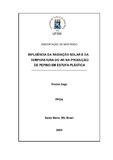| dc.creator | Zago, Vivairo | |
| dc.date.accessioned | 2017-05-16 | |
| dc.date.available | 2017-05-16 | |
| dc.date.issued | 2004-07-15 | |
| dc.identifier.citation | ZAGO, Vivairo. Influence of the solar radiation and of temperature on cucumber yield in greenhouse. 2004. 90 f. Dissertação (Mestrado em Agronomia) - Universidade Federal de Santa Maria, Santa Maria, 2004. | por |
| dc.identifier.uri | http://repositorio.ufsm.br/handle/1/4958 | |
| dc.description.abstract | It was studied the influence of the variables global solar radiation and air temperature about the production of cucumber. It was used data of yield was studied was used data of production of each harvest along the reproductive period of the cucumber plant of ten experiments conducted in greenhouse installed in the Experimental, Field of the Department of Fitotecnia UFSM in Santa Maria, State of Rio Grande do Sul, RS, during the period of 1992-2003. The experiments (E) were realized of the following manner: the E1 was in 1992, E2 and E3 were in 1996, E4 was in 1997, E5 was in 1998, E6 and E7 were in 1999, E8 was in 2000, E9 was in 2002 and E10 was 2003. In six of the experiments, the number of genotypes constituted themselves of two until five and in the other of one genotype. It was evaluated the productivity of each growing in the different experiments and epochs of year, it was calculated the thermal sum above 12°C to the reproductive period and or harvest and was made a statistical analyses through a regression among productivity and the variables global solar diary radiation and the thermal sum above 12°C. The results indicated that the production of that cucumber plant cultivated inside that greenhouses generally is upper to the conducted to field and that occurs yield variations among epochs and years of cultivation and among genotypes. The influence of the temperature and of the solar radiation with relation to production of fruit was variable among the epochs and dependent of the intensity of the meteorological elements. Some for genotypes the thermal sum during the cultivations of autumn/winter was lower however the reproductive cycle was upper. The analysis of regression demonstrated that the relationship
between the production of fruits and the accumulated sum of the temperature above 12°C and of the global solar radiation among the crops was adjusted better for the spring times / summer. | eng |
| dc.format | application/pdf | por |
| dc.language | por | por |
| dc.publisher | Universidade Federal de Santa Maria | por |
| dc.rights | Acesso Aberto | por |
| dc.subject | Pepineiro | por |
| dc.subject | Produtividade | por |
| dc.subject | Radiação solar | por |
| dc.subject | Temperatura do ar | por |
| dc.subject | Cucumber | eng |
| dc.subject | Productivity | eng |
| dc.subject | Solar radiation | eng |
| dc.subject | Temperature | eng |
| dc.title | Influência da radiação solar e da temperatura do ar na produção de pepino em estufa plástica | por |
| dc.title.alternative | Influence of the solar radiation and of temperature on cucumber yield in greenhouse | eng |
| dc.type | Dissertação | por |
| dc.description.resumo | Estudou-se a influência das variáveis radiação solar global e temperatura do ar sobre a produção de pepino. Utilizou-se dados de produção de cada colheita ao longo do período reprodutivo do pepineiro, de dez experimentos conduzidos em estufa plástica instaladas no Campo Experimental do Departamento de Fitotecnia-UFSM, Santa Maria, Estado do Rio Grande do Sul, RS, período 1992-2003. Os experimentos (E) foram realizados da seguinte maneira: o E1 em 1992, E2 e E3 em 1996, E4 em 1997, E5 em 1998, E6 e E7 em 1999, E8 em 2000, E9 em 2002 e E10 2003. Em seis dos experimentos o número de genótipos constituíram-se de dois, até cinco e nos demais de um genótipo. Avaliou-se a produtividade de cada cultivar nos diferentes experimentos e épocas do ano, calculou-se a soma térmica acima de 12°C para o período reprodutivo e/ou colheita e fez-se uma análise estatística através de uma regressão entre produtividade e as variáveis radiação solar global diária e a soma térmica acima de 12ºC. Os resultados indicaram que a produção do pepineiro cultivado no interior de estufas geralmente é superior ao conduzido a campo e que ocorre variações de rendimento entre épocas e anos de cultivo e entre genótipos. A influência da temperatura e da radiação solar com relação a produção de frutos foi variável entre as épocas, e dependente da intensidade dos elementos meteorológicos. Para alguns genótipos a soma térmica durante os cultivos de outono/inverno foi inferior, no entanto o ciclo reprodutivo foi superior. A análise de regressão mostrou que a relação entre a
produção de frutos e a soma acumulada da temperatura acima de 12°C e da radiação solar global entre as colheitas se ajustou melhor para as épocas de primavera/verão. | por |
| dc.contributor.advisor1 | Buriol, Galileo Adeli | |
| dc.contributor.advisor1Lattes | http://buscatextual.cnpq.br/buscatextual/visualizacv.do?id=K4787739U1 | por |
| dc.contributor.referee1 | Heldwein, Arno Bernardo | |
| dc.contributor.referee1Lattes | http://buscatextual.cnpq.br/buscatextual/visualizacv.do?id=K4788078U3 | por |
| dc.publisher.country | BR | por |
| dc.publisher.department | Agronomia | por |
| dc.publisher.initials | UFSM | por |
| dc.publisher.program | Programa de Pós-Graduação em Agronomia | por |
| dc.subject.cnpq | CNPQ::CIENCIAS AGRARIAS::AGRONOMIA | por |


